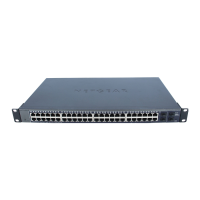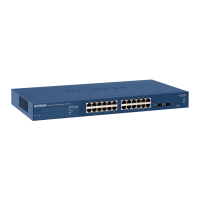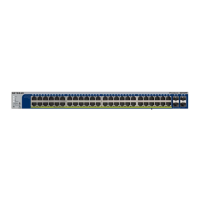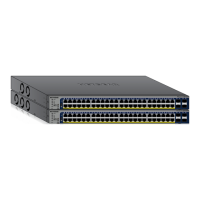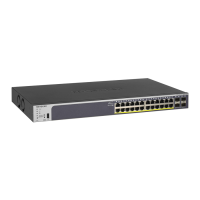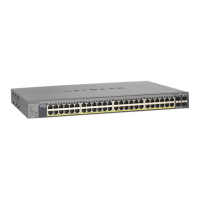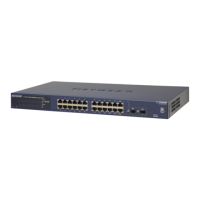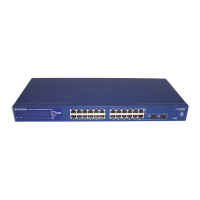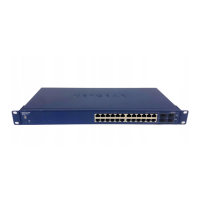158
GS748T Smart Switch
• Ethernet Type. Select an EtherType keyword or enter an EtherType value to add a
match condition based on the EtherType value.
• Source MAC. Requires a packet’s source MAC address to match the address
specified here.
• Source MAC Mask. Indicates which bits in the source MAC address are significant
and which are ignored. An F indicates that the bit is significant, while a 0 indicates that
the bit is ignored. For example, a MAC mask of FF:FF:FF:FF:FF:FF indicates that all
bits in the source MAC address are used as match criteria.
• Destination MAC. Requires a packet’s destination MAC address to match the
address specified here.
• Destination MAC Mask. Indicates which bits in the destination MAC address are
significant and which are ignored. An F indicates that the bit is significant, while a 0
indicates that the bit is ignored. For example, a MAC mask of FF:FF:FF:FF:FF:FF
indicates that all bits in the destination MAC address are used as match criteria.
• Protocol Type. Select a layer 4 protocol to use for the match criteria in the packet or
select Other and enter the value to match in the Protocol field of the IP packet. The
valid range is 0–255.
• Source IP Address. Requires a packet’s source port IP address to match the
address listed here. In the IP Address field, enter a valid source IP address in dotted
decimal format.
• Source Mask. Enter a valid subnet mask to determine which bits in the IP address
are significant. Note that this is not a wildcard mask.
• Source L4 Port. Requires a packet’s TCP/UDP source port to match the port you
select. Select the desired L4 keyword from the list on which the rule can be based. If
you select Other, the screen refreshes and a Port ID field appears. Enter a
user-defined Port ID by which packets are matched to the rule.
• Destination IP Address. Requires a packet’s destination port IP address to match
the address listed here. In the IP Address field, enter a valid destination IP address in
dotted decimal format.
• Destination Mask. Enter a valid subnet mask to determine which bits in the IP
address are significant. This is not a wildcard mask.
• Destination L4 Port. Requires a packet’s TCP/UDP destination port to match the port
you select. Select the desired L4 keyword from the list on which the rule can be
based. If you select Other, the screen refreshes and a Port ID field appears. Enter a
user-defined Port ID by which packets are matched to the rule.
• IP DSCP. Matches the packet’s DSCP to the class criteria’s when selected. Select the
DSCP type from the menu or enter a DSCP value to match. If you select Other, enter
a custom value in the DSCP Value field that appears.
